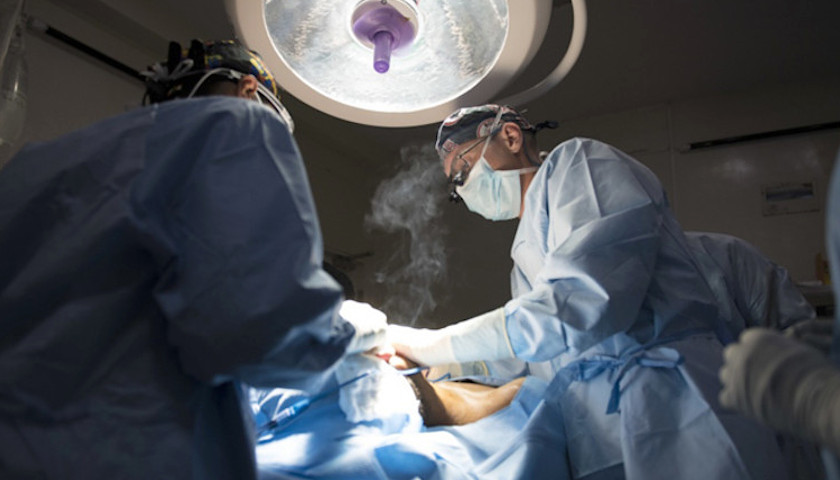A new epidemiological model cited by White House officials shows that Ohio hospitals have sufficient regular hospital bed and ICU hospital bed capacity for when the peak of the coronavirus hits the state in the upcoming weeks.
According to the Institute for Health Metrics and Evaluation (IHME) model, Ohio is projected to see its resources peak on April 20. The model shows that the Buckeye State will need 5,609 beds; however, the state presently has 14,290 beds available, according to the study.
Furthermore, Ohio is expected to need 854 intensive care unit (ICU) beds by April 20, the date the model projects the pandemic will peak in Ohio, but it already has 12,238 ICU beds ready to go.
In terms of deaths, the IHME model predicts Ohio will have 1,672 by August 4. As of Tuesday, Ohio Department of Health (ODH) numbers show 55 people have died from the coronavirus.
Dr. Deborah Birx, the White House coronavirus task force adviser, said recently IHME model, which is funded by the University of Washington and the Bill and Melinda Gates Foundation, shows projections very much in line with how the federal government viewed the situation.
Birx and Dr. Anthony Fauci recently said that as many as 100,000 to 200,000 could die in the United States due to COVID-19. The IHME model currently shows a wide range of possible deaths, with an upper bound of 160,000 and the most likely outcome 83,945 deaths from COVID-19 between now and August 4.
This IHME projection is dramatically lower than the projections Gov. DeWine referenced on Friday, but provided no details on.
As The Star reported:
Gov. DeWine began his discussion of the modeling of the growth coronavirus cases in Ohio with a vague conflation of modeling activities he said were being conducted by the Cleveland Clinic with the projections of ODH Director Acton which are, apparently, based on data from “epidemiology researchers” at Ohio State University, a group which The Ohio Star believes is led by Professor Rempala, who is a biostatistician.
“This morning, I had a call from the Cleveland Clinic and they gave us the new information that they have in regard to their modeling and their projections. And I’ll give you the basis of that modelling and what that result was in just a moment,” DeWine said.
“A couple points highlights from what we were told this morning by the Cleveland Clinic in their modeling. First of all, within about two weeks, we will continue to see it go up – in about two weeks we will see it kick in a little harder. And we’re really going to start seeing it very hard in our hospital admissions,” DeWine said, adding:
They project that we may not hit the peak until, now, mid-May. Again, modelling is a science, it’s an art.
But this is the best information – the newest information – that I want to share with you. In addition to that, they are telling us, we need now to look to a two and possible three times build-out of what we have today in our hospital beds, ICU beds. . .
At this point in the press conference, Gov. DeWine pulled what can only be described as a modeling sleight of hand.
Having introduced the idea of modeling and branding it as something associated with the Cleveland Clinic – though offering no specifics as to the model’s projections – he pivoted to the model used by ODH’s Acton based upon the work of some unidentified Ohio State University epidemiology researchers (but presumably Dr. Rempala’s) and repeated the same draconian projections Acton has made for the past several weeks.
“The chart up here – this is the chart that Dr. Acton was showing you. Again, this is the projected peak,” DeWine said, as he pointed to the April 19th Projected Peak of 10,000 New Cases Per Day-Mitigated.
“And so, that projected peak [April 19th 10,000 mitigated] if we’re looking at – we need to go up three times in our capacity – it is somewhere in this area here,” DeWine says, pointing at a place in the chart about equal to 3,000 new cases per day on April 19.
Cleveland Clinic (CC) spokesperson Shannon Nealon told The Ohio Star on Tuesday the CC model is using “leveraging predictive modeling to create projections on how COVID-19 may affect its own healthcare system as well as hospitals across Ohio.”
“This modeling can help project the rate of infection and subsequent use of much needed healthcare resources including ICU beds and ventilators.Currently, if social distancing efforts do not impact the spread of COVID-19, our hospitalization model is predicting a peak in mid-May where hospitals across Ohio should anticipate a surge of COVID-19 patients,” she said.
Nealon told The Star this projection is based on “actual hospitalization rates across Ohio as reported on coronavirus.odh.gov.”
“Social distancing efforts will help to reduce the peak number of people hospitalize and will delay the time to peak infections (dampen the curve). As we continue to encourage social distancing, the model is updated regularly to reflect how Ohio’s efforts to slow down the spread of COVID-19 are working to help flatten the curve,” she said.
The clinic noted social distancing efforts impacted the model’s predictions after two weeks.
Nealon did not specify the number of cases of COVID-19 or the number of deaths projected in the CC model.
Notably, at a Friday press conference, Gov. DeWine pointed to a chart showing projections based on data from unnamed Ohio State University epidemiologists showing the peak in the state on April 19, not mid-May as Nealon told The Star the CC model projects.
Professor Grzegorz Rempala, who The Star identified as the developer of an Ohio State University (OSU) model likely used as the basis of the ODH Model, said the CC model is based off of a Susceptible, Infected and Recovered (SIR) model. A SIR model is “is an epidemiological model that computes the theoretical number of people infected with a contagious illness in a closed population over time,” according to Wolfram Mathworld.
Rempala said the CC model is different than OSU’s model because his school’s model uses the idea of proximity network. The term proximity network means that not every one interacts with everyone else, but that people have a certain network of people they interact with, according to the professor.
“We are introducing in our model these parameters that measure how much proximity networks change from social distancing and quarantining,” he said. “We are attempting to make this model dynamic in the sense that we are taking into account the changes in people’s behavior.”
In comparison to the IHME model, Rempala said these two were hard to compare. He told The Star the IHME study had a wide range of predictions like his study does.
“If you are looking at some these wide range of predictions, some of these are overlapping,” he said.
Last week, ODH released a chart with data provided by epidemiology researchers from OSU that showed the peak for the state is going to be April 19 with 10,000 new cases.
The ODH model estimates peak requirements are four times greater than the IHME model.
Rempala, who teaches biostatistics at the school, gave a presentation on March 24 at OSU’s Mathematical Biosciences Institute called “Mathematical Models of Epidemics: Tracking Coronavirus Using Dynamic Survival Analysis.”
The results Rempala’s model showed during this presentation appeared to be similar with those presented by Acton on Friday.
“We would see a peak of an epidemic of about 7,000 cases per day in about 30 days. . .10,000 if no social distancing,” he said on the 24th, three days before the Friday press conference.
Rempala said that ODH is using several models beside his own. The professor was unsure of how much of the information he has provided to the health department was being used.
In addition, Rempala said it is hard to tell if the projection of 10,000 daily new cases at the height of the coronavirus in Ohio would come down as more data is compiled.
“We don’t completely understand how these measures put in place how they are effecting the epidemic because there was not enough time here to fully see that,” he said.
Rempala said he hopes to have a better idea within the next couple of days.
Dan Tierney, Gov. DeWine’s press secretary, told The Star on Tuesday that DeWine, Dr. Acton, and the ODH team looks at a variety of models and take them all into account in their analysis.
“The bottom line is that most modeling indicates that COVID-19 will have a significant impact on Ohio and we are preparing to ensure all Ohioans are able to receive the care they need,” Tierney said.
In public presentations made by DeWine and Acton the only chart presented with visual presentations of coronavirus projections is the one that shows 10,000 new cases per day at a peak on April 19 that says it was based on data developed by Ohio State University epidemiology researchers.
As of Tuesday, the Buckeye State has 2,199 total cases of coronavirus since the beginning of the pandemic.
– – –
Zachery Schmidt is the digital editor of Star News Digital Media. If you have any tips, email Zachery at [email protected]. Samantha Witwer contributed to this article.





